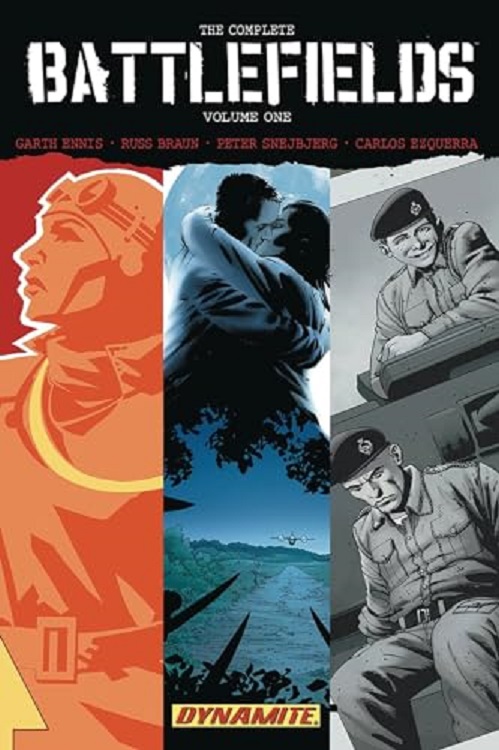Comic Book Review: The Complete Battlefields Volume One written by Garth Ennis, art by various.
World War Two has been a favorite subject of comic books since the beginning of that conflict. Garth Ennis grew up on British war comics, and enjoys writing about the subject. So it’s not surprising that he did three miniseries for Dynamite Comics on various aspects of the war under the umbrella title of Battlefields. This volume collects them.

“Night Witches” art by Russ Braun, concerns the female pilots who operated as night bombers for the Soviet Army. Their outdated biplanes were notoriously noisy, so out of necessity they had to cut the engines kilometers from the target and glide in to drop their bombs. Their silent approach and seeming appearance from nowhere spooked the German troops, who nicknamed them the “Nacht Hexen.”
The story follows two viewpoints. The Soviet side is represented by Lieutenant Anna Kharkova, a short pilot whose co-pilot comes up with the gliding idea. At first, she and her squadmates are resented and belittled by their male comrades, but after they prove their bravery and skill, earn respect. Anna even starts an affair with a male pilot. But this is war, and death is all around even in the air–worse if you’re forced to the ground.
On the German side, we follow Kurt Graf, a foot soldier of the Third Squad. He’s already questioning the wisdom of invading Russia. He’s okay with killing Commie soldiers–this is war, and he’s a soldier. But he is less down with the idea that the enemy is subhuman, and with the atrocities his sergeant wants the squad to participate in. But when you put on a Nazi uniform, you’re a Nazi, regardless of your personal qualms or low opinion of Hitler.
These two eventually cross paths. Who will survive?
“Dear Billy”, art by Peter Snejbjerg, introduces us to British nurse Carrie Sutton, who’s writing a letter to Billy Wedgewood, a pilot she’s been having an affair with. We learn that she was in Singapore when the Japanese invaded. She and the other women at the British hospital there were raped and shot, left for dead. Carrie somehow survived, and wound up being treated at a hospital in Calcutta. When she recovered physically, they voluntold her to become a nurse there, as there was certainly a need.
Carrie, raised in the “soiled forever” tradition, doesn’t tell anyone what happened before she was shot, and buries herself in her work until she meets Billy. He fibs that he’s got a digestive ailment, but he’s actually at the hospital to get counseling for the nightmarish experience he himself had with the Japanese. Carrie overhears this and feels a connection. She doesn’t tell him that she knows, or her own trauma, even as they become romantically involved.
While Billy’s back at the front, a Japanese soldier is brought in under guard. He’s been badly injured enough that he was captured/surrendered. Indeed, he was so badly injured that no one suspects a thing when Carrie murders him.
Carrie becomes something of a serial killer of Japanese prisoners. Naturally, she keeps this from Billy, even as their relationship deepens and the war winds its way towards the end. It’s not sustainable, though. Eventually, it all falls apart and Carrie must face that she and Billy have different goals.
“Tankies” pencils by Carlos Ezquerra, inks by Hector Ezquerra, takes place in the days after D-Day as the British Army tries to get to the positions it needs to be in to allow the Americans to strike the German army properly. One Churchill tank, Oboe One Baker, loses its ranking officer to an artillery barrage.
To get the relatively green crew moving again, they’re sent Corporal Stiles, a Geordie hard man with a thick accent as their new tank commander. The rest of the crew is from around London, and the only one that can decipher his words at first is Cockney gunner “Robbo” Robinson. Unfortunately, Robbo is none too fond of hard men, Geordies, or non-commissioned officers, so there’s a lot of friction.
This one’s a bit more in the traditional war movie mode, with several subplots involving characters elsewhere in the battlefield, and the O1B crew learning to work together and even enjoy a small triumph against a far more powerful Tiger tank.
These are three very different stories with different presentation styles, though I can very much tell Garth Ennis wrote all of them. I liked Tankies best, perhaps because of the Ezquerra art I remember so fondly from British comics of the past. There’s plenty of action, and some philosophy.
Mr. Ennis includes an afterword which sorts through what’s based in fact and what’s fictional. He defends the depiction of atrocities as true to the history. There’s also concept art, and a bibliography of sources if the reader feels like doing their own research.
Content note: Frequent lethal violence, often with gore, and sometimes very personal. Suicide. Rape. Consensual extramarital sex. Male and female nudity (no genitals). Racism and ethnic prejudice. Period sexism. Homophobia in passing. Lots of rough language. Very much not for children or sensitive readers.
If you’re a fan of Garth Ennis’ other works, and want something more realistic, or if you enjoy your war comics with moral ambiguity, this might be the collection for you.

